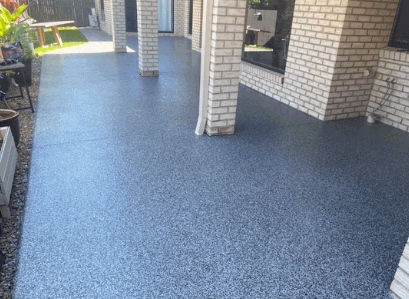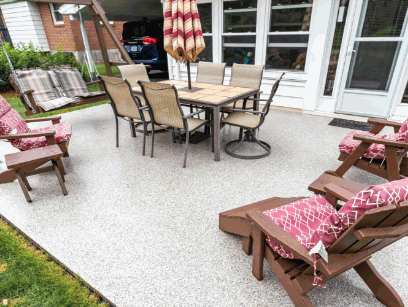Epoxy flooring is popping up more and more in outdoor settings. It has many advantages which make it a great option for driveways, patios, and more.
It’s resistant to UV rays, moisture, and chemicals. Plus, unlike wooden or concrete surfaces, it won’t crack or deteriorate due to weather changes. This means you won’t have to pay for frequent repainting or repairs.
It also offers slip resistance. Its textured surface prevents accidents in areas where water collects, such as pool decks.
You can get creative and customize your outdoor space. Epoxy flooring comes in a range of colors and finishes, from glossy to rustic stone-like looks.
On top of all that, epoxy is eco-friendly. It’s made of low-VOC materials and won’t release toxins into the environment. It’s good for homeowners and the ecosystem.

What is epoxy flooring?
Epoxy flooring is a tough and adaptable surface made from epoxy resin and curing agents. It offers a glossy look that is resistant to chemicals, spots, and abrasion. This seamless option is often used in commercial and industrial spaces due to its strength and attractive appearance.
Outdoors, epoxy flooring is a great pick for a number of reasons. Firstly, it is incredibly durable versus the elements like ultraviolet rays, rain, and temperature shifts. Unlike concrete or wood, epoxy does not fade, crack, or peel due to sunlight or moisture.
Furthermore, epoxy flooring provides added safety features for outdoor areas. It can be customized with non-slip additives which decrease the risk of falls, notably in wet settings. This makes it ideal for pool decks, patios, and other outdoor spots where slip resistance is essential.
In addition, epoxy flooring is straightforward to clean and maintain outside. Its non-porous surface prevents dirt, gunk, and stains from seeping into the floor. Sweeping and mopping regularly is generally enough to keep the floor looking brand new.
Pro Tip: To extend the life of your outdoor epoxy flooring, apply a UV-resistant coat every couple of years. This will safeguard the floor from discoloration and keep it looking vibrant for longer.
Discover: How To DIY Epoxy Flooring
Benefits of epoxy flooring
Epoxy flooring is the perfect pick for outdoor spaces! It offers amazing features like:
- Durability – resistant to cracks and abrasions. Heavy foot traffic won’t damage it.
- Chemical resistance – can handle exposure to gasoline or oil spills.
- Easy to clean – its smooth surface allows for quick and effortless cleaning with a mop or broom.
- Customizable – comes in various colors and patterns, allowing you to customize the style of your outdoor area.
- UV resistance – won’t fade or yellow in direct sunlight.
- Seamless surface – prevents the growth of mold or bacteria, ensuring a hygienic environment.
Remember: Before applying epoxy flooring outdoors, make sure the surface is properly prepared for maximum adhesion.
Limitations of epoxy flooring
Epoxy flooring is renowned for its durability and versatility. But, when it comes to outdoor use, there are some limitations. For example, UV rays can cause the epoxy to fade and discolor – particularly darker colors. Also, temperature fluctuations can cause the epoxy to expand or contract, potentially leading to cracks. Lastly, when wet, it can become quite slippery – a safety hazard in areas with water present.
It’s worth noting that these limitations may vary depending on the quality of the epoxy and the installation process. Therefore, consulting an expert contractor who specializes in outdoor epoxy flooring is recommended.
Don’t miss out on this amazing opportunity! Despite the limitations, epoxy flooring is an excellent choice to enhance your outdoor aesthetics and functionality. Speak to an expert to explore the possibilities and take your outdoor space to the next level.
Considerations for outdoor use
When using epoxy flooring outdoors, there are a few factors to take into account. These six points should be kept in mind:
- Choose a high-quality epoxy made for outdoor use. This guarantees strength and resistance against different weather.
- Prep the outdoor surface correctly. Clean and make sure it’s free of any contaminants or moisture.
- Make sure the epoxy has UV resistance. This will protect it from sunlight exposure.
- Consider temperature changes in the region. The epoxy needs to be able to handle this without cracking or peeling.
- Maintain the outdoor epoxy flooring regularly. Cleaning and reapplying a protective topcoat will extend its lifespan.
- Think of the intended use of the outdoor space. If it’s exposed to heavy foot traffic or chemicals/oils, choose an epoxy with enhanced durability and chemical resistance.
Also, some types of epoxy flooring may be unsuitable for outdoor applications. Ask a professional or contact the manufacturer for more info.
It’s great to know that epoxy flooring has been used in various industries due to its dependability. According to Construction Executive magazine, this type of flooring has proved its value over the years.*

Conclusion
Epoxy flooring can be great for outdoor spaces – it has many pros! Durable, low-maintenance & weather-resistant? Yes, please! Just one thing to watch out for: it can be slippery when wet. Over time, it may need resealing too.
Pros:
- Durable – ideal for areas with heavy foot traffic & harsh weather.
- Low Maintenance – easy to keep clean & looking good.
- Weather-resistant – protects against UV rays, temperatures, moisture & chemicals.
Con:
- Slippery when wet – be careful around pools & rainy areas.
- Requires resealing – a fresh layer of epoxy coating must be applied over time.







